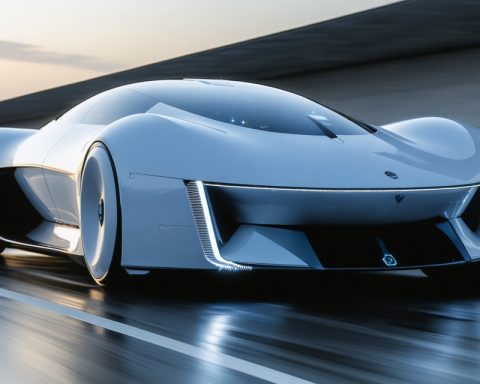- The electric vehicle (EV) market is experiencing rapid growth, with global sales surpassing 10 million in 2022.
- Major automakers and startups, such as Tesla and Rivian, are investing heavily in electrification, reshaping the automotive industry.
- Government regulations and incentives, including emissions targets and tax breaks, are encouraging the shift from fossil fuels to greener vehicles.
- Challenges persist, including the need for an expanded charging infrastructure to alleviate range anxiety among potential buyers.
- EVs offer significant environmental benefits by reducing greenhouse gas emissions and life-cycle pollutants compared to traditional vehicles.
- The transition to electric vehicles symbolizes a move towards a sustainable future, inviting everyone to join the green revolution.
The hum of progress reverberates through bustling city streets as the electric vehicle (EV) market accelerates into a promising future. Once a niche segment, the world of EVs has burst into the mainstream, capturing the imagination of eco-conscious consumers and tech enthusiasts alike. But what’s fueling this meteoric rise, and where is it headed?
Picture this: A sleek electric car, powered by whisper-quiet technology, glides down an open highway, framed by a backdrop of sprawling solar farms and wind turbines. This vision isn’t just a possibility—it’s rapidly becoming our reality. Globally, the shift towards electric cars is gaining speed: In 2022, EV sales worldwide exceeded 10 million, a staggering increase that marks a pivotal moment in the automotive industry.
Major automakers and ambitious startups are racing to dominate this evolving landscape. Companies like Tesla, with its groundbreaking Supercharger network, and newcomers such as Rivian, crafting rugged electric trucks and SUVs, are redefining mobility. Traditional giants like General Motors and Volkswagen aren’t standing still either, pouring billions into electrification and pledging all-electric futures.
But it’s not only manufacturer ambition driving this shift—regulatory policies steer the course. Governments across the globe, from the United States to the European Union, are mandating stringent emissions targets, incentivizing consumers to transition to greener vehicles. Tax breaks, rebates, and zero-emission zones are pushing buyers to reconsider their options, shifting perspectives from fossil fuels to renewable energy sources.
Yet, the road isn’t without its bumps. The development of robust charging infrastructures lags behind the soaring tenure of EV adoption. Range anxiety, though diminishing, persists as a concern among potential buyers. To quell these fears, the race is on to create denser networks of fast-charging stations, ushering in a new era of convenient, long-distance electric travel.
The environmental impact also plays a pivotal role: Switching to EVs could drastically reduce greenhouse gas emissions, a critical step towards combating climate change. Vehicles that run on electricity instead of gasoline are responsible for fewer life-cycle pollutants, an appealing fact for consumers mindful of their carbon footprint.
In weaving together this vibrant tapestry of innovation and sustainability, the electric vehicle market does more than merely offer a better car—it promises a better world. As more people climb aboard this green revolution, plugging into cleaner transportation, the message becomes clear: The future of travel is electric, and everyone is invited to join the journey.
In the click of a button, we aren’t just starting engines; we’re igniting a transformation. So, the next time you see an electric vehicle gliding silently by, remember: It’s not just a car. It’s a move towards a brighter, sustainable tomorrow.
Electric Vehicles: Driving Towards a Sustainable Future
The Electric Vehicle Surge: What’s Behind the Growth?
The accelerated adoption of electric vehicles (EVs) can be attributed to several key factors, including technological advancements, consumer preferences, and environmental imperatives. Here are some additional insights:
1. Technological Innovations: The development of electric cars has advanced significantly, with modern EVs offering improved battery range and performance. Innovations such as solid-state batteries promise safer and more efficient energy storage, potentially extending EV ranges in the near future (source: Tesla).
2. Consumer Preferences: There’s a growing shift in consumer mindset towards environmental sustainability, driven by greater awareness of climate change. This is encouraging more individuals to opt for EVs as part of their daily lifestyle choices.
3. Government Incentives: Governments worldwide are implementing strategies like rebate programs, tax incentives, and zero-emission zones to promote the electrification of transport. For example, countries such as Norway offer extensive incentives that have resulted in EVs making up over 70% of new car sales.
4. Corporate Responsibility: Companies are increasingly committing to sustainability goals, and integrating electric vehicles into corporate fleets provides an avenue to meet these environmental targets.
Addressing Challenges: Infrastructure and Range Anxiety
One of the primary hurdles in the widespread adoption of electric vehicles is the inadequate charging infrastructure. Here are practical approaches being employed:
1. Expanding Charging Networks: Collaborations between governments, private companies, and automakers are underway to expand charging infrastructure. Tesla, for instance, continues to grow its Supercharger network to ease long-distance travel concerns.
2. Wireless Charging: New technology is emerging, like wireless or induction charging pads embedded in parking spaces, facilitating effortless EV charging.
3. Improved Battery Technologies: Advancements in battery technology, such as increased energy density and faster charging times, are gradually reducing range anxiety among consumers.
Real-World Use Cases and Predictions
1. Urban Mobility: EVs are increasingly being integrated into urban mass transit systems. Cities like Shenzhen in China have transitioned their public bus fleet to all-electric models.
2. Ride-Sharing Services: Companies like Uber and Lyft are encouraging drivers to switch to EVs, aiming for a fully-electric fleet by the 2030s.
Market Forecast and Industry Trends
– Growth Projection: Analysts predict that by 2030, electric vehicles may constitute up to 50% of all new car sales globally.
– Autonomous Vehicles: The intersection of electric and autonomous technologies is expected to redefine mobility, with major players investing heavily in self-driving EVs.
Pros and Cons Overview
Pros:
– Reduced greenhouse gas emissions
– Lower operating costs per mile compared to internal combustion engines
– Low maintenance requirements
Cons:
– High upfront purchase costs (partially offset by incentives)
– Limited charging infrastructure in some regions
– Longer refueling times compared to gasoline vehicles
Actionable Recommendations for Prospective EV Owners
– Research Incentives: Before purchasing, research available national and local incentives to minimize costs.
– Assess Driving Habits: Evaluate your typical driving range needs and check local charging infrastructure availability to ensure an EV fits your lifestyle comfortably.
– Explore Charging Solutions: Consider investing in a home charging setup if you have access to a garage or driveway.
Conclusion
The journey towards an electric future is rapidly advancing, supported by swift innovations and collaborative efforts. By embracing electric vehicles, consumers play an active role in fostering a sustainable future while enjoying modern technological conveniences. As the market continues to evolve, staying informed and making savvy purchasing decisions will be key to maximizing the benefits of this green transportation revolution.





















